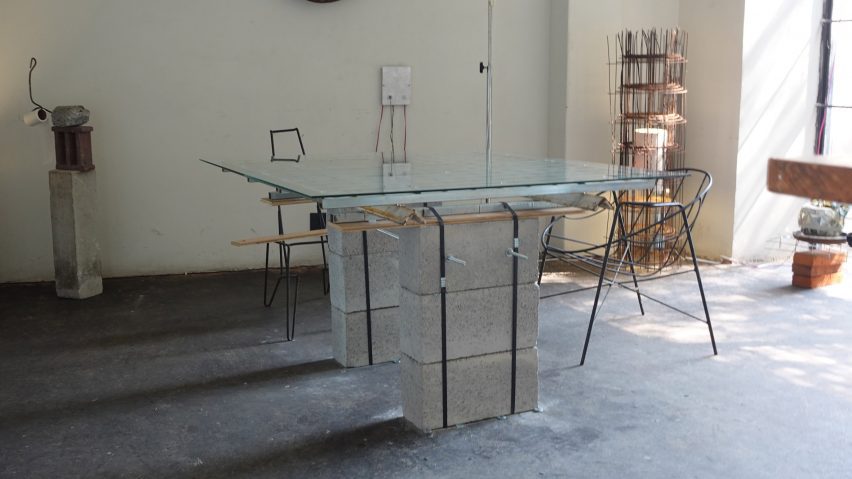Mexican architect Javier Guzmán Cervantes has collected urban waste materials including cinderblocks and rebar to create a series of furniture for a show in Mexico City.
Working with his research project Ex Soup, Cervantes gathered materials from construction sites and waste deposits throughout the city to create an exhibition at design gallery Utíl.
Curated in collaboration with the arts organisation Lugar Vivo, the Construcciones Domésticas exhibition (Household Constructions) includes objects ranging from tables and chairs to lighting and day beds.
Cervantes told Dezeen that the project was exercised to shed light on the ecological effects of waste in construction, the lack of options in affordable, durable furniture and the need for architects to free themselves from the "mental realm of design" and focus on making.
"I think these times that we are living in require us to explore new lifestyles and new ways of configuring our domestic interiors, more attuned with the present global economic and environmental reality," said Cervantes.
He added that new values must be garnered from industrial landscapes and ecological ruin.
"This is exactly the spirit of Ex Soup, to take discarded materials and transform them into something beautiful and useful to life in a process that prioritizes energy efficiency and practical thinking."
Cervantes said that he has been working on creating furniture from salvaged materials since his teens, but only recently began formalising the practice, founding Ex Soup in 2022.
Much of the material comes from the architect's daily life, while driving or walking, as well as from materials discarded from construction sites and given to him by friends.
The name, Ex Soup, is a reference to his preferred materials: industrial products like metal and glass that "were heated liquids in their production processes and were given shapes".
Projects included in Household Constructions consist of mixes of different materials stacked to create recognisable forms, and many were created without the use of glue to create "ergonomic shapes" held together by tension.
Among the works is a coffee table constructed using steel beams with surfaces created from a discarded mirror and glass.
The work of tension is most obvious in some of the taller pieces, such as a desk. Cervantes stacked pieces of paving stone and PVC piping in two pillars and used strapping to hold up the desktop, which was created from a reused headboard.
Many of the pieces are simple and have a brutalist effect, given the steel and concrete used in their construction, while others are more colourful, such as a divan covered with an expressive weave of scrap clothing.
Rolls of electrowelded mesh also feature heavily in the collection, at times serving as supports for a console and at others serving as lamp shades.
Cervantes said that the pieces were meant to show the large number of combinations possible in using these materials.
"There are some pieces that are easily replicable since many times trash comes in patterns, but I would say I see Ex Soup more as an endless search for new shapes and ways of perceiving materials, so the focus is in constantly adapting to change and variation," he said.
Other furniture made using scrap materials includes a chair made from old musical instruments by Jay Sae Jung and a series of Knoll chairs refashioned with used car parts by Noel Mercado.
The photography is by Javier Guzman.
Household Constructions is on view at Utïl in Mexico City from 8 November to January 2024. For more events and exhibitions in architecture and design visit the Dezeen Events Guide.

